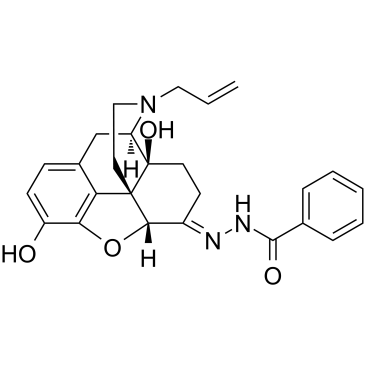119630-94-3
| Name | Naloxone benzoylhydrazone |
|---|---|
| Synonyms | naloxone benzoylhydrazone |
| Description | Naloxone benzoylhydrazone (NalBzoH) is a mixed agonist/antagonist. Naloxone benzoylhydrazone is a prototypic κ3-opioid receptor agonist, and a partial agonist at the cloned μ and δ opioid receptors, and an antagonist at opioid-like NOP receptors. Naloxone benzoylhydrazone has potently analgesia effect[1][2][3]. |
|---|---|
| Related Catalog | |
| Target |
κ3-opioid receptor; μ- and δ-opioid receptors; Opioid-like NOP receptors[1][2] |
| In Vitro | At the mu-opioid receptor (MOR), Naloxone benzoylhydrazone stimulates [35S]GTPγS binding (pEC50=8.59) and inhibits cyclic AMP accumulation (pEC50=8.74) with maximal effects (Emax) corresponding to 55 and 65% of those obtained with the MOR agonist DAMGO, respectively[1]. At the κ-opioid receptor (KOR), Naloxone benzoylhydrazone stimulates [35S]GTPγS binding (pEC50=9.70) and inhibits cyclic AMP formation (pEC50=9.45) [1]. In CHO cells expressing the δ-opioid receptor (DOR), Naloxone benzoylhydrazone increases [35S]GTPγS binding (pEC50=8.49) and inhibits cyclic AMP formation (pE50=8.61)[1]. |
| In Vivo | Analgesic studies in mice examining increasing doses of Naloxone benzoylhydrazone with a fixed dose of morphine reveals a biphasic curve. Naloxone benzoylhydrazone at doses as low as 1 μg/kg partially antagonized morphine analgesia. Higher Naloxone benzoylhydrazone doses continued to inhibit morphine analgesia in a dose-dependent manner, with the 1-mg/kg dose antagonizing completely morphine analgesia. As the Naloxone benzoylhydrazone dose increased beyond 1 mg/kg analgesia returned. Naloxone benzoylhydrazone also prduces a similar analgesic response when administered alone in mice and also is active in rats. Naloxone benzoylhydrazone has excellent p.o. activity, with an analgesic potency in mice equivalent to s.c. administration. In addition to blocking morphine analgesia, low doses of Naloxone benzoylhydrazone also partially reverses the inhibition of gastrointestinal transit in mice produced by morphine, antagonizes completely morphine lethality and precipitates withdrawal in morphine-dependent mice[4]. |
| References |
[2]. Connor M, et al. Has the sun set on kappa3-opioid receptors? Br J Pharmacol. 2006 Feb;147(4):349-50. |
| Density | 1.44g/cm3 |
|---|---|
| Molecular Formula | C26H27N3O4 |
| Molecular Weight | 445.51000 |
| Exact Mass | 445.20000 |
| PSA | 94.39000 |
| LogP | 2.84710 |
| Index of Refraction | 1.722 |
| Personal Protective Equipment | Eyeshields;Gloves;type N95 (US);type P1 (EN143) respirator filter |
|---|---|
| RIDADR | NONH for all modes of transport |
| WGK Germany | 3 |
